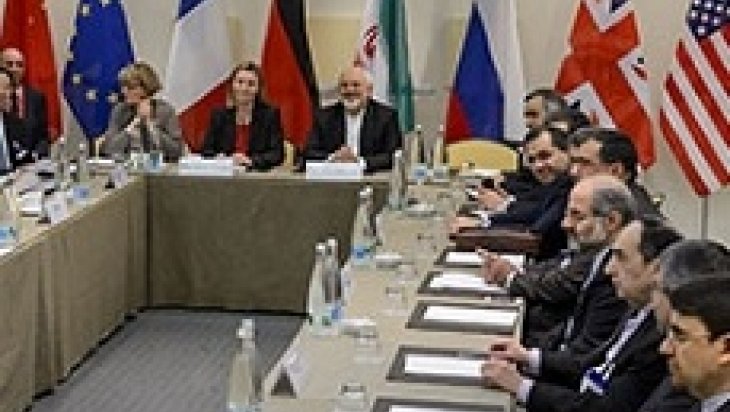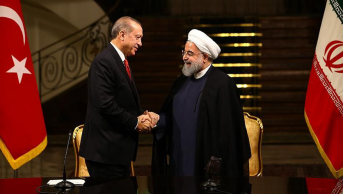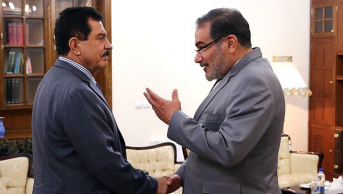Lausanne Talks: Deal,but not an Agreement

Last week, a remarkable step is takenas a result of negotiations that aimed to find a diplomatic solution to the stalemate over Iranian nuclear program. Foreign Ministers of the P5+1states (Permanent Members of UN Security Council and Germany) and Iran come together in Lausanne, Switzerland, on March 26. Thenegotiations, whichwere held within the framework of Joint Action Plan (JAP) that had been signed in Geneva in November 2013, reached a deal at the end of eight-day talks. Federica Mogherini, High Representative of EU for Foreign Affairs and Security Policy and M. JavadZarif, Foreign Minister of Iran,issued a joint statement and announced a general framework of the settled points.
The Lausanne ‘Deal’
The joint statement issued by Mogherini and Zarifdeclared that the parties agreed on the points thatIran will continue to pursue a peaceful nuclear program while ‘Iran’s enrichment capacity, enrichment level and stockpile will be limited for specified durations.’ In return, the sanctions imposed on Iran by the EU, the United States, and the UN Security Council for its nuclear program will be terminated. Additionally, it is declared that negotiations will continue till June 30th to prepare a comprehensive agreement (Joint Comprehensive Plan of Action, JCPOA) on the basis of the settled points in Lausanne.
Both American President Barack Obama and Iranian President Hassan Rouhani called the Lausanne deal as an “historical development.” Indeed the negotiations between Iran and the P5+1 have two fundamental aims: to ensurepeacefulness of Iranian nuclear program and to relieve Iran from sanctions imposed for its nuclear program. It appears that the parties have agreed on these fundamental issues. Obama pointed that out that limitations and verification measures proposed in the Lausanne deal will keep Iran at least one year away from nuclear-break out capacity for the following ten or more years. He also stated that this settlement as ‘a good deal’ as it settled almost all issues related to nuclear program of Iran. As to Rouhani, the Lausanne deal was successful because it provided an international recognition to Iran’s nuclear program and proposed relieve of all sanctions.
As widely known, the P5+1 countries, particularly the United States have three major concerns related to Iranian nuclear program, which are incorporated into the relevant UN Security Council Resolutions. First, they have been worried with Iranian attempts to enrich uranium,whichis deemed to be employedin developing nuclear weapons. Currently Iran is enriching uranium at a level of 20 percent, and it has built a new underground facility to enrich uranium in Fordow,which was projected to be secure from military attacks. The second major concern is stemmed from the heavy-water reactor built in Arak. The P5+1 is alarmed with the fact that the plutonium to be produced in this reactor would be useful for nuclear weapons. Finally, the P5+1 countries are worried with possible military dimensions of Iranian nuclear program. This concern is amplified because of the lack of adequate measures to verify and review Iranian nuclear program.
According to the deal in Lausanne, “there will be no enrichment facility other than Natanz” in Iran. “Iran’s research and development on centrifuges will be carried out on a scope and schedule that has been mutually agreed.” All centrifuges will be first generation centrifuges (IR-1).For 15 years, Iran will not build any new facilities for the purpose of enriching uranium; will not enrich uranium over 3,67 percent; and keep its stockpile of enriched uranium below 300 kg. “Fordow will be converted from an enrichment site into a nuclear, physics and technology center.” Heavy-Water Research Reactor in Arak will be redesigned to prevent production of weapons grade plutonium.
It is specified in the joint statement issued in Lausanne that Iran agreed to implement the modified Code 3.1 and Additional Protocol to the Nuclear Safeguards Agreement, which will provide the International Atomic Energy Agency (IAEA) with comprehensive measures to monitor and verify Iranian nuclear program. The EU and the United States will terminate the implementation of nuclear-related economic and financial sanctions, simultaneously with the IAEA-verified implementation by Iran of its key nuclear commitments. “A new UN Security Council Resolution will endorse the JCPOA, terminate all previous nuclear-related resolutions and incorporate certain restrictive measures for a mutually agreed period of time.”
Reactions to the Lausanne Deal in Iran
Iranian people and media largely welcomed the Lausanne deal that set the key parameters for the projected comprehensive agreement. Most of the Friday prayer leaders including Ayatollah EmamiKashani, imamjom’eh of Tehran, articulated their support to the deal. The deal is mostly welcomed in Iran because of three reasons.
First, Iranian nuclear rights are recognized by the international community through the Lausanne deal. After a series of heavy pressure and sanctions to prevent Iranian nuclear program since 2002, the western countries eventually accepted nuclear rights of Iran including the right to enrich uranium. Moreover, the Lausanne deal does not necessitate destruction, suspension or cease of Iranian nuclear facilities. That is, all nuclear facilities will be intact.
The second reason for the extensive support to the deal in Iran is the decision for the removal of sanctions. It was the greatest motivation of Iran for the negotiations. Until now, the UN Security Council adopted six resolutions including sanctions against Iran for its nuclear activities. In addition to the UN sanctions, the United States and the EU adopted a number of financial and economic sanctions against Iran. Those sanctions adversely affected virtually all aspects of daily life in Iran from energy sector to civil aviation, from international trade to financial activities. Particularly, the recent oil embargo and the isolation of Iran from international financial networks crippled Iranian economy. The Lausanne deal requires the removal of all nuclear-related UN sanctions, and the termination of the implementation of American and European sanctions. The removal or the termination of the sanctions is expected to contribute much to the revival ofIranian economy. That is why the deal is mostly welcomed among the Iranians.
Additionally, it is thought that the solution of the nuclear conflict through the deal will boost Iran’s foreign policy as well. As it is known, Iran’s relations with the western countries and the regional countries were worsened due to the disagreement on nuclear issue. The Lausanne deal is supposed to provide a framework for Iranian nuclear program that it will not pose a threat to international community. Therefore, it is anticipated that the nuclear issue will no more create a challenge for Iranian foreign policy, and will improve its international standing.
Although it is widely welcomed in Iran, strong criticisms are raised against the deal soon after the release of its details. In fact, since the Geneva agreement a group of neo-radical or ultra conservative politicians and commentators (delvapasan) have declared their worries with the negotiations. Those people including some members of National Security and Foreign Policy Committee in the Majlis opposed the Lausanne deal as well. The deal was heavily criticized by dailies such as Vatan-eEmrooz, allegedly associated with former president Mahmoud Ahmadinejad, and Keyhan known to be close to Supreme Leader Ali Khamenei. Critiques of the deal have also widely covered in some websites as Mashreghnews and Fars News Agency, claimed to be associated the Revolutionary Guards.
Above else, critiques of the deal mostly focused on the uncertainty about formal status and content of the Lausanne deal. Actually, a framework agreement was supposed to be signed till the end of March. Instead of a framework agreement, however, the parties released a statement to declare solutions reached at the end of eight-day talks. Opponents of the deal argued that the promises given in the talks are binding, which in fact turned the deal into an ‘agreement.’
One of the most controversial points with regard to the Lausanne deal is the uncertainty surrounding the details. There are three different texts containing some parts of the deal.The first one is the statement released by Mogherini and Zarif in Lausanne, which reflects some key points settled to constitute a solid base for the comprehensive agreement, without mentioning details. Additionally, there are two different statements issued by the US State Department and Iranian Foreign Ministry. Despite the existence of some common points in these two statements, they are noticeably different with regard to the details. While achievements of Iran were highlighted in Iranian statement, the State Department provided detailed information on proposed constraints and verifications over Iranian nuclear program in the statement it released. Because of the differences between the three statements, opponents of the deal charged Iranian government with concealing some parts of the ‘agreement’ from people.
The uncertainty surrounding time and mode of the removal of sanctions is another source of debate with related to the deal. The three statements addressed this issue in different ways. The statement of Iranian Foreign Ministry states that all sanctions will be relieved when the comprehensive agreementis put into force. The joint statement differentiates between European and American sanctions, and UN sanctions. Accordingly, the EU and the United States will terminate “the implementation of all nuclear-related economic and financial sanctions simultaneously with the IAEA-verified implementation by Iran of its key nuclear commitments.” For the UN sanctions, it is stated, “A new UN Security Council Resolution will endorse the JCPOA, terminate all previous nuclear-related resolutions and incorporate certain restrictive measures for a mutually agreed period of time.” According to the American statement, “U.S. and EU nuclear-related sanctions will be suspended after the IAEA has verified that Iran has taken all of its key nuclear-related steps. If any time Iran fails to fulfill its commitments, these sanctions will snap back into place.” With related to the removal of UN sanctions, the American statement detailed, “All past UN Security Council resolutions on the Iran nuclear issue will be lifted simultaneously with the completion of nuclear-related actions by Iran addressing all key concerns (enrichment, Fordow, Arak, PMD, and transparency).” The ‘worrieds’ (delvapasan) claim that all IAEA reports about Iranian nuclear program are biased and against the interests of Iran. Therefore, any specific role assigned to the IAEA in the process of removal of sanctions could be viewed as a sign that sanctions will remain.
Another controversial point is related to the implementation of the Additional Protocol to the Nuclear Safeguards Agreement between the IAEA and Iran, signed in November 2004. According to the Lausanne deal, Iran will start the approval process in the Majlis, but until then it agreed to the provisional application of the Additional Protocol. This protocol provides the IAEA with an authority to monitor and review every place without any previous notice. Critics of the deal argued that by accepting such a commitment the Iranian delegation went beyond its authority and moved into the jurisdiction of Majlis. They also asserted that it is a dangerous commitmentbecause such kind of verifications will make sensitive facilities in the country accessible for potential spies.
Opponents of the Lausanne deal claim that the Iranian negotiators gave clear and precise, but unacceptable concessions. For instance, despite built to be secure from military attacks,the commitment to convert Fordow from uranium enrichment site to nuclear and physics research center, and not to begin enrichment activities for 15 years is an intolerable compromise. Similarly, the commitments of Iran to reduce its installed centrifuges from about 19,000 to 6,104; to reduce its current stockpile of about 10,000 kg of low-enriched uranium to 300 kg are painful concessions given to the P5+1 group.
The relevance of the deal for Iran’s ballistic missile program is also debated. Although Iranian government said that military programs are not covered by the deal, the American statement on the deal included; “Iran will implement an agreed set of measures to address the IAEA’s concerns regarding the Possible Military Dimensions (PMD) of its program.” Opponents of the deal argue that this expression could be interpreted in a way to include ballistic missile program of Iran.
Conclusion
The Lausanne deal set the key parameters for the definitive comprehensive agreement with the aim to solve the conflict on Iranian nuclear program through diplomatic channels. The comprehensive agreement is proposed to be completed till the end of the coming June. In other words, the talks in Lausanne are not culminated in an agreement, but in a settlement and a deal on some key points. The talks between Iran and the P5+1 countries will continue until the completion of the comprehensive agreement. Nevertheless, the reached solutions in the Lausanne talks will largely shape the comprehensive agreement.
The Lausanne deal and the comprehensive agreement proposed to be completed in late June may end the conflict over Iranian nuclear program in a peaceful way, but it will not end debates on this issue. Above else, Iran will be the only country whose nuclear program is constrained so much. For this reason, some Iranians will continue to decry that Iran is discriminated by international community that prevented, or curbed, its nuclear rights. Additionally, the parties are apparently agreed for some constraints for specified periods on Iranian nuclear program. However, it is not clear what will happen at the end of that specified periods, which raises new questions about Iranian nuclear program.










